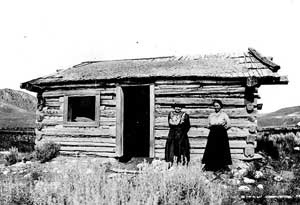In about 1860, Americans John Utz (b. 1824) and Hiram Francis Smith (1829-1893) settle in the Okanogan Valley near Lake Osoyoos. They are the first white residents of the area and although Utz may have preceded Smith, Smith is regarded as the county's First Citizen.
Prior to 1860, the Okanogan Valley was unsettled by whites between the mouth of the Columbia and Lake Osoyoos on the Canadian border. Paths along the river called the Okanogan Trail had been heavily traveled by prospectors and cattlemen en route to gold fields on the Fraser River in British Columbia.
Little is known about "Buckskin John" Utz who fenced 12-16 acres and built a cabin between the mouth of Nine Mile Creek canyon and the trail on the east side of the lake. He married an Indian woman named Dorothy. They resided with Dorothy's sister Tenas ("little") Catherine Utz. The Utz cabin became the first U.S. Customs House on Lake Osoyoos in 1879.
Hiram Francis "Okanogan" Smith was a printer who left the newspaper business to hunt for gold in California in 1849. When prospecting did not pan out, he ran a freight line out of The Dalles, Oregon, serving the northern gold fields and he operated a trading post at Hope and Rock Creek. His travels took him through the Okanogan Valley, which offered mild winters, sufficient rain, and abundant grass.
To legitimize his claim on unsurveyed Indian land, Smith took as his wife a 14-year-old Indian girl named Mary. Smith became an industrious farmer and packed 1,200 young fruit trees onto his property and developed 24 acres of apples and eight acres of peaches, pears, and grapes. Five of the trees were still producing in 1990. He also raised cattle, ran a trading post, and served in the territorial and state legislatures.
Utz caught salmon, which he sold to the Indians. In the census of 1870, he listed himself as a saloonkeeper even though saloons were prohibited on Indian land. Smith and Utz were the only white residents of what would become Okanogan County until 1873.

